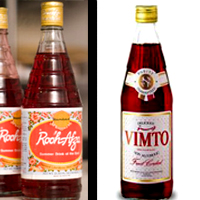Home Page › Halal Meat › VIMTO Syrup Saudi Fruit Cordial Holy Joes Indian Groceries and Halal Market

Apr 25
VIMTO Syrup Saudi Fruit Cordial Holy Joes Indian Groceries and Halal Market
With Ramadan here, both drinks brands will be vying to reach the maximum number of iftar tables.
While Vimto claims to be the most popular Ramadan drink in the Arab world, Muslims across Pakistan and India sip on Rooh Afza as they break their fast during the holy month. How do the two match up?
Origins
Both the sherbets have been around for a long time – Rooh Afza was created in 1907, by Hakim Abdul Majid, the founder of the company Hamdard Laboratories. The drink is very popular in India and Pakistan, where it is manufactured. It is also made in Bangladesh, and available all across the world.
Vimto came into existence a year later, when Noel Nichols invented the fruity purple drink in the UK. The drink came to the region slightly later, when Saudi-based Aujan industries began locally importing it in 1927. Vimto, manufactured by Nichols Plc grew in popularity in the region, and in 1975 a company called Solent Canners negotiated a license from Nichols to produce canned carbonated Vimto for sale to Saudi Arabia and Kuwait and then later also the UAE. In 1978 and 1979 they were awarded the Queen’s Award for Export Achievement on the strength of the Middle Eastern sales. In 1980 Nichols purchased Solent Canners.
Content
Both the drinks are made of a combination of fruits, herbs and spices. Rooh Afza, which is mainly rose-scented, also includes syrups of orange, pineapple, carrot and watermelon, flowers, some medicinal herbs and vegetable extracts. Vimto is mainly fruit- concentrate.
Both are in syrup form, are pinkish in color and extremely sweet. They are energy-producing drinks, and that’s why the popularity during Ramadan.
Both are in syrup form, are pinkish in color and extremely sweet. They are energy-producing drinks, and that’s why the popularity during Ramadan.
While Rooh Afza is mainly mixed with milk (called Rose milk at times), it can also be mixed with several other drinks. Some add it with Sprite and milk, some with a soda, and others with plain water. It is also used as an add-on to desserts, and is poured over ice-cream and Falooda for its flavor.
Vimto generally only serves as a drink, and is also mixed with either soda or water.
Advertising
Vimto has relied hugely on advertising to push its sales. Last year, the company claims to have sold 20 million Vimto bottles across the GCC during the month long Ramadan, which it attributes to the ‘Haykhalasso’ (Hurry, They’ll finish it all!) campaign.
The ads showed a world in which people panicked at the prospect of Vimto running out. In one, a distraught woman who has dreamt her hoard of Vimto is missing attacks her husband with a bat, only to be reassured the bottles are safe.
This year, Vimto is targeting young Arab mother through its ad campaign, says Aujan’s marketing manager, because they are the decision makers. The company, which is mainly using television campaigns, hopes to have an increase of 5 percent from last year.
The brand is now worth around $350m worldwide (as of February this year). The first Vimto television advert appeared in 1956 and cost around $195.
Rooh Afza on the other hand, has had a very limited advertising, and has relied more on word-of-mouth. However, the company recently announced that it has just sharpened its marketing strategy, and also roped in Indian actress Juhi Chawla as its brand ambassador. The marketing campaign is being prepared by advertising agency JWT. Roohafza brand maker Hamdard Laboratories is planning to post a 33 per cent growth and turnover of more than $56m this year. It is aiming for a 26 percent sales growth for Rooh Afza.





